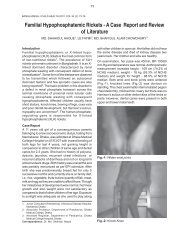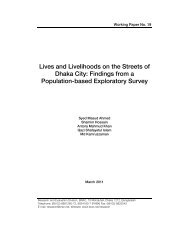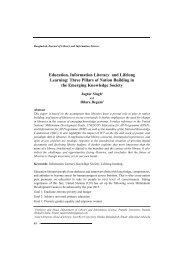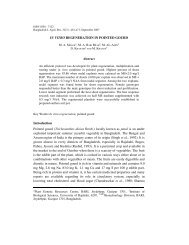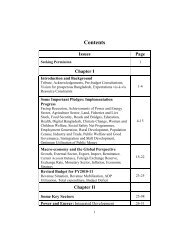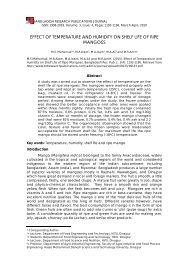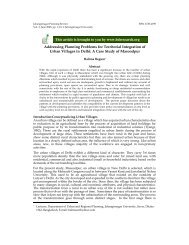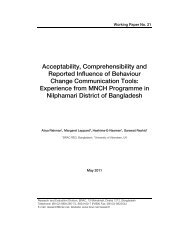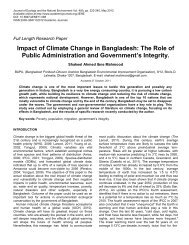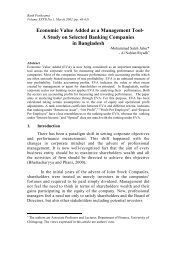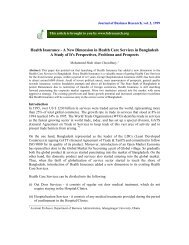Studies on Policy Option for Quality Seed Production and ... - NFPCSP
Studies on Policy Option for Quality Seed Production and ... - NFPCSP
Studies on Policy Option for Quality Seed Production and ... - NFPCSP
Create successful ePaper yourself
Turn your PDF publications into a flip-book with our unique Google optimized e-Paper software.
last ploughing. After 1 st irrigati<strong>on</strong> (18-22 days after sowing) 115 kg/ha urea are applied as top-dressing.Previously, farmers did not c<strong>on</strong>trol weed neither by mechanical weeding or using weedicide. From thelast year (2007) some farmers are using weedicide (Affinity) to c<strong>on</strong>trol weed. It is applied <strong>on</strong>ce in afield.Disease <strong>and</strong> pest management: There are few insects that attack wheat. Sometimes, termite attacks inthe seedling stage, which is c<strong>on</strong>trolled by insecticides (e.g. Darsbern or Briefer 5G). Aphid <strong>and</strong> stemborer may attack but applicati<strong>on</strong> of insecticide is not ec<strong>on</strong>omic. Only Kanchan variety was to found beaffected by Bipolarise Leaf Blight (BpLB) <strong>and</strong> this variety was later replaced.Irrigati<strong>on</strong> <strong>and</strong> water management: All the farmers irrigate at least <strong>on</strong>ce <strong>and</strong> it is made 18-21 daysafter sowing. Some farmers apply water <strong>on</strong>ce more, which is at 45-60 days after sowing. From recentpassed time, farmers have been using plastic hosepipe <strong>for</strong> irrigati<strong>on</strong>. Some are irrigating their crop byflood irrigati<strong>on</strong> system.Rouging: Farmers generally cultivate grain crops <strong>and</strong>some porti<strong>on</strong> of which they keep as seed. Majority ofthe farmers do not isolate seed plots, do not do rouging,<strong>and</strong> are not careful about seed admixture in threshing<strong>and</strong> drying. Farmers are not aware of it. A negligiblenumber of farmers do rouging.Harvesting <strong>and</strong> post-harvest management: Farmersharvest their wheat crop manually <strong>and</strong> thresh bythresher <strong>on</strong> the day of harvesting or 1-2 days afterharvest. Depending <strong>on</strong> grain moisture, they dry thePlate 4.2.6 Varietal admixture in wheat fieldgrains in sun <strong>for</strong> 2-5 days. They clean the grains <strong>and</strong>grade by using Kula. They become sure about the moisture c<strong>on</strong>tent by chewing the grain. After sundrythey keep the grain in shade <strong>for</strong> cooling. Then they keep the seed in drum or in polyethylene bag.<strong>Seed</strong> storage: About 60% of the farmers store seeds in their houses <strong>for</strong> own use <strong>and</strong> some of themstore <strong>for</strong> sale. They keep their own seeds in drum lined with polyethylene bag <strong>and</strong> then put it <strong>on</strong> a layerof bricks <strong>on</strong> the floor of the house. After properly drying (2-3 sun dry), they clean the seeds throughh<strong>and</strong> winnowing <strong>and</strong> keep it within poly bags with jute sack cover. Some of the farmers keep seeds inmetal/plastic drum. Majority of the farmers do not do germinati<strong>on</strong> test properly. They detect good seedsby observing physical appearance like boldness, shining color, insect presence etc.Cost <strong>and</strong> return of wheat cultivati<strong>on</strong>: Human labour was 80 man-days <strong>and</strong> cost was Tk. 9,600/ha(Table 4.2.28). Most of the farmers used herbicide <strong>for</strong> c<strong>on</strong>trolling weeds as it reduces human labor usecompared to the traditi<strong>on</strong>al practice of manual weeding. L<strong>and</strong> preparati<strong>on</strong> cost was Tk. 2,161/ha. In thereporting seas<strong>on</strong>, about 80% farmers used new variety Prodip <strong>and</strong> Bijoy seeds, <strong>and</strong> most of the farmerspurchased the seeds from others. <strong>Seed</strong> rate was 148 kg/ha <strong>and</strong> cost <strong>for</strong> that was Tk. 5920/ha,72



